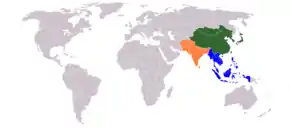Eastern culture
Eastern culture, also known as Oriental culture, is an umbrella term for various cultural heritages of social norms, ethical values, traditional customs, belief systems, political systems, artifacts and technologies of the Eastern world. As such, there is no singular "Eastern culture" except as opposed to Western culture.


.svg.png.webp)

Terminology

The East, as a geographical area, is unclear and undefined. More often, the ideology of a state's inhabitants is what will be used to categorize it as a Eastern society. There is some disagreement about what nations should or should not be included in the category and at what times. Many parts of the Eastern Roman (Byzantine) Empire are considered to be distinct from the west and therefore labelled as eastern by most scholars. The Byzantine empire was primarily influenced by eastern practices due to its proximity and cultural similarity to Iran and Arabia, thus lacking features seen as "Western".
It is difficult to determine which individuals fit into which category and the East–West contrast is sometimes criticized as relativistic and arbitrary.[1][2][3] Globalism has spread Western ideas so widely that almost all modern cultures are, to some extent, influenced by aspects of Eastern culture. Stereotypical views of "the East" have been labeled Orientalism, paralleling Occidentalism—the term for the 19th-century stereotyped views of "the West".
As Europeans discovered the smaller world, old concepts adapted. The area that had formerly been considered the Orient ("the East") became the Near East as the interests of the European powers interfered with Meiji Japan and Qing China for the first time in the 19th century.[4] Thus, the Sino-Japanese War in 1894–1895 occurred in the Far East while the troubles surrounding the decline of the Ottoman Empire simultaneously occurred in the Near East.[lower-alpha 1] The term Middle East in the mid-19th century included the territory east of the Ottoman Empire, but West of China—Greater Persia and Greater India—is now used synonymously with "Near East" in most languages.
Traditions
Eastern culture has developed many themes and traditions. Some important ones are listed below:
Religion
- Abrahamic religions (a.k.a. West Asian religions)
- Christianity – the majority of the modern world adheres to this faith, although, it isn't widely practiced in its native continent of Asia anymore and since the faith had spread to the Western world the notion of "Europe" and the "Western World" has been intimately connected with the concept of "Christianity and Christendom" many even attribute Christianity for being the link that created a unified European identity.[5] Nonetheless, vibrant indigenous minorities in the Levant, Anatolia, Fars, and Kerala have preserved their ancient beliefs, adhering to Syriac Christianity (i.e. Assyrian and Maronite people), an Eastern Christian sect.[6] Significant Christian communities also found in Central Asia, China, Hong Kong, India, Indonesia, Japan, Macau, Malaysia, South Korea, Singapore, Taiwan and Vietnam.[7]
- Islam – the majority of the world Muslim population have always lived in Asia, due to Islam spreading and becoming the dominant religion of these areas.
- Judaism – the national religion of the Israelites/Hebrews of the Fertile Crescent,[8] or what is now Israel, Palestine, Jordan, Syria, and Lebanon. They eventually evolved into the Jews (particularly Ashkenazi, Sephardic, Mizrahi) and Samaritans of today.
- Druze faith – are esoteric ethnoreligious group and they reside primarily in Syria, Lebanon, Israel and Jordan.[9]
- Zoroastrianism – the monotheistic state religion of Sassanid Iran
- Eastern religions / Eastern philosophy
- Indian religions
- Buddhism – the path of liberation attained through insight into the ultimate nature of reality.
- Hinduism
- Jainism
- Sikhism – a religion that developed in the warring plains of Punjab in an atmosphere of ideological clash between Islam and Hinduism. Its followers retain spiritual as well as martial qualities.
- Taoic religions (a.k.a. East Asian religions)
- Chinese folk religion
- Confucianism – the belief that human beings are teachable, improvable and perfectible through personal and communal endeavour especially including self-cultivation and self-creation.
- Shinto
- Taoism
- Indian religions
Cinema
- East Asian cinema
- Middle Eastern cinema (including Arab cinema)
Cuisine
- Middle Eastern cuisine (including Arab cuisine)
- Armenian cuisine
- Assyrian cuisine
- Azerbaijani cuisine
- Bahraini cuisine
- Cypriot cuisine
- Egyptian cuisine
- Emirati cuisine
- Iranian cuisine
- Iraqi cuisine
- Israeli cuisine
- Jordanian cuisine
- Kurdish cuisine
- Kuwaiti cuisine
- Lebanese cuisine
- Levantine cuisine
- Mizrahi Jewish cuisine
- Omani cuisine
- Palestinian cuisine
- Qatari cuisine
- Saudi Arabian cuisine
- Syrian cuisine
- Turkish cuisine
- Yemeni cuisine
- South Asian cuisine
- Central Asian cuisine
- East Asian cuisine
- Southeast Asian cuisine
Culture
- East Asian culture
- Southeast Asian culture
- Middle Eastern and Arab culture
- South Asian culture
- Western Asian culture
Gallery
 Mongolian Buuz
Mongolian Buuz Kebabs are a popular cuisine among Middle Easterners.
Kebabs are a popular cuisine among Middle Easterners..jpg.webp) Round challah, a special bread in Jewish cuisine
Round challah, a special bread in Jewish cuisine Sushi has become prevalent even among westerners.
Sushi has become prevalent even among westerners. Armenian khash (or pacha), which is also commonly eaten by Assyrians, Arabs and Kurds.
Armenian khash (or pacha), which is also commonly eaten by Assyrians, Arabs and Kurds. Ramoji Film City located in Hyderabad, holds the Guinness World Record for the World's largest film studio.[10]
Ramoji Film City located in Hyderabad, holds the Guinness World Record for the World's largest film studio.[10]

 The Tian Tan Buddha statue in Hong Kong.
The Tian Tan Buddha statue in Hong Kong. A Syro-Malabar Catholic bishop holding the Mar Thoma Christian Cross which symbolizes the heritage and identity of the Syrian Church of Saint Thomas Christians of India
A Syro-Malabar Catholic bishop holding the Mar Thoma Christian Cross which symbolizes the heritage and identity of the Syrian Church of Saint Thomas Christians of India The Monastery of St. Matthew, located atop Mount Alfaf in northern Iraq, is recognized as one of the oldest Christian monasteries in existence.
The Monastery of St. Matthew, located atop Mount Alfaf in northern Iraq, is recognized as one of the oldest Christian monasteries in existence. Assyrian Christians from lake Urmia in north eastern Persia in their traditional costumes.
Assyrian Christians from lake Urmia in north eastern Persia in their traditional costumes..jpg.webp)





_01.jpg.webp) Aerial view of Masada, Israel
Aerial view of Masada, Israel


 Minangkabau Tari Lilin (candle dance)
Minangkabau Tari Lilin (candle dance)
Family
Families have a great importance in Eastern cultures. They teach their children about how the family is their protection and the major source of their identity. Parents expect loyalty from their children. Parents define the law and the children are expected to obey them. This is called filial piety, the respect for one's parents and elders, and it is a concept that originated in China as 孝 (xiao) from Confucian teachings.[11] Children are expected to have self-control, thus making it hard for them to express emotions. They are also expected to show respect through their motions and the way they speak. Children are expected to look after their parents when they grow older.[12] Sons are expected to stay home, while daughters eventually leave and live with their husband's family. In Chinese culture, children are occasionally expected to care for their elders (赡养), and in various diaspora communities one may find Chinese children living with their grandparents.
Bibliography
- Berger, Mark T. (1997). "The triumph of the East? The East-Asian Miracle and post-Cold War capitalism". In Borer, Douglas A. (ed.). The rise of East Asia: critical visions of the Pacific century. Routledge. pp. 260–261, 266. ISBN 0-415-16168-1.
Notes
- British archaeologist D.G. Hogarth published The Nearer East in 1902, which helped to define the term and its extent, including Albania, Montenegro, southern Serbia and Bulgaria, Greece, Egypt, all Ottoman lands, the entire Arabian Peninsula, and Western parts of Iran.
References
- Yin Cheong Cheng, New Paradigm for Re-engineering Education. p. 369
- Ainslie Thomas Embree, Carol Gluck, Asia in Western and World History: A Guide for Teaching. p. xvi
- Kwang-Sae Lee, East and West: Fusion of Horizons
- Davidson, Roderic H. (1960). "Where is the Middle East?". Foreign Affairs. 38 (4): 665–75. doi:10.2307/20029452. JSTOR 20029452. S2CID 157454140.
- Dawson, Christopher; Glenn Olsen (1961). Crisis in Western Education (reprint ed.). p. 108. ISBN 9780813216836.
- Hindson, Edward E.; Mitchell, Daniel R. (1 August 2013). The Popular Encyclopedia of Church History. Harvest House Publishers. p. 225. ISBN 9780736948074.
- "Global Christianity – A Report on the Size and Distribution of the World's Christian Population" (PDF). Pew Research Center.
-
 This article incorporates text from a publication now in the public domain: Kohler, Kaufmann (1901–1906). "Judaism". In Singer, Isidore; et al. (eds.). The Jewish Encyclopedia. New York: Funk & Wagnalls.
This article incorporates text from a publication now in the public domain: Kohler, Kaufmann (1901–1906). "Judaism". In Singer, Isidore; et al. (eds.). The Jewish Encyclopedia. New York: Funk & Wagnalls. - C. Held, Colbert (2008). Middle East Patterns: Places, People, and Politics. Routledge. p. 109. ISBN 9780429962004.
Worldwide, they number 1 million or so, with about 45 to 50 percent in Syria, 35 to 40 percent in Lebanon, and less than 10 percent in Israel. Recently there has been a growing Druze diaspora.
- "Ramoji Film City sets record". Business Line. Archived from the original on 8 December 2008. Retrieved 3 August 2007.
- "Cultural Values of Asian Patients and Families – Dimensions of Culture". www.dimensionsofculture.com. Archived from the original on 21 November 2016. Retrieved 15 November 2016.
- "The Value and Meaning of the Korean Family". Asia Society. Retrieved 15 November 2016.
